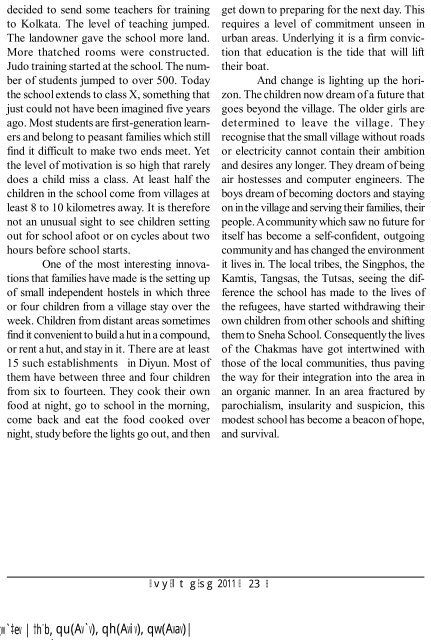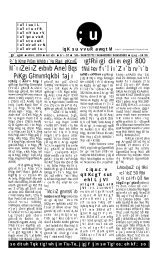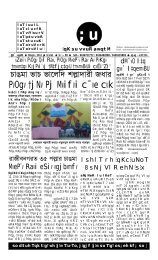Create successful ePaper yourself
Turn your PDF publications into a flip-book with our unique Google optimized e-Paper software.
decided to send some teachers for training<br />
to Kolkata. The level of teaching jumped.<br />
The landowner gave the school more land.<br />
More thatched rooms were constructed.<br />
Judo training started at the school. The number<br />
of students jumped to over 500. Today<br />
the school extends to class X, something that<br />
just could not have been imagined five years<br />
ago. Most students are first-generation learners<br />
and belong to peasant families which still<br />
find it difficult to make two ends meet. Yet<br />
the level of motivation is so high that rarely<br />
does a child miss a class. At least half the<br />
children in the school come from villages at<br />
least 8 to 10 kilometres away. It is therefore<br />
not an unusual sight to see children setting<br />
out for school afoot or on cycles about two<br />
hours before school starts.<br />
One of the most interesting innovations<br />
that families have made is the setting up<br />
of small independent hostels in which three<br />
or four children from a village stay over the<br />
week. Children from distant areas sometimes<br />
find it convenient to build a hut in a compound,<br />
or rent a hut, and stay in it. There are at least<br />
15 such establishments in Diyun. Most of<br />
them have between three and four children<br />
from six to fourteen. They cook their own<br />
food at night, go to school in the morning,<br />
come back and eat the food cooked over<br />
night, study before the lights go out, and then<br />
vw`‡ev | †h¨b, qu(Av`v), qh(Aviv), qw(Avav)|<br />
BB vIyUElt gIEsgIH<br />
<strong>2011</strong> BB<br />
get down to preparing for the next day. This<br />
requires a level of commitment unseen in<br />
urban areas. Underlying it is a firm conviction<br />
that education is the tide that will lift<br />
their boat.<br />
And change is lighting up the horizon.<br />
The children now dream of a future that<br />
goes beyond the village. The older girls are<br />
determined to leave the village. They<br />
recognise that the small village without roads<br />
or electricity cannot contain their ambition<br />
and desires any longer. They dream of being<br />
air hostesses and computer engineers. The<br />
boys dream of becoming doctors and staying<br />
on in the village and serving their families, their<br />
people. A community which saw no future for<br />
itself has become a self-confident, outgoing<br />
community and has changed the environment<br />
it lives in. The local tribes, the Singphos, the<br />
Kamtis, Tangsas, the Tutsas, seeing the difference<br />
the school has made to the lives of<br />
the refugees, have started withdrawing their<br />
own children from other schools and shifting<br />
them to Sneha School. Consequently the lives<br />
of the Chakmas have got intertwined with<br />
those of the local communities, thus paving<br />
the way for their integration into the area in<br />
an organic manner. In an area fractured by<br />
parochialism, insularity and suspicion, this<br />
modest school has become a beacon of hope,<br />
and survival.<br />
23 BB









